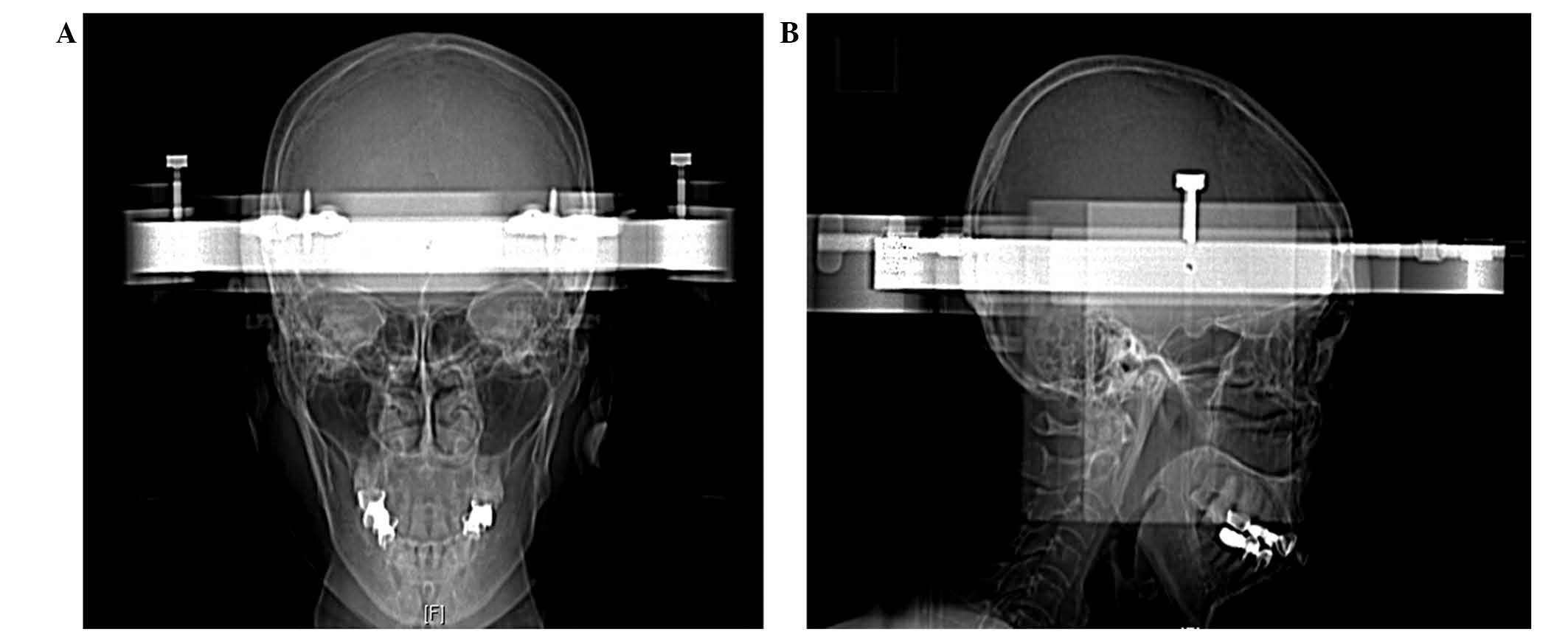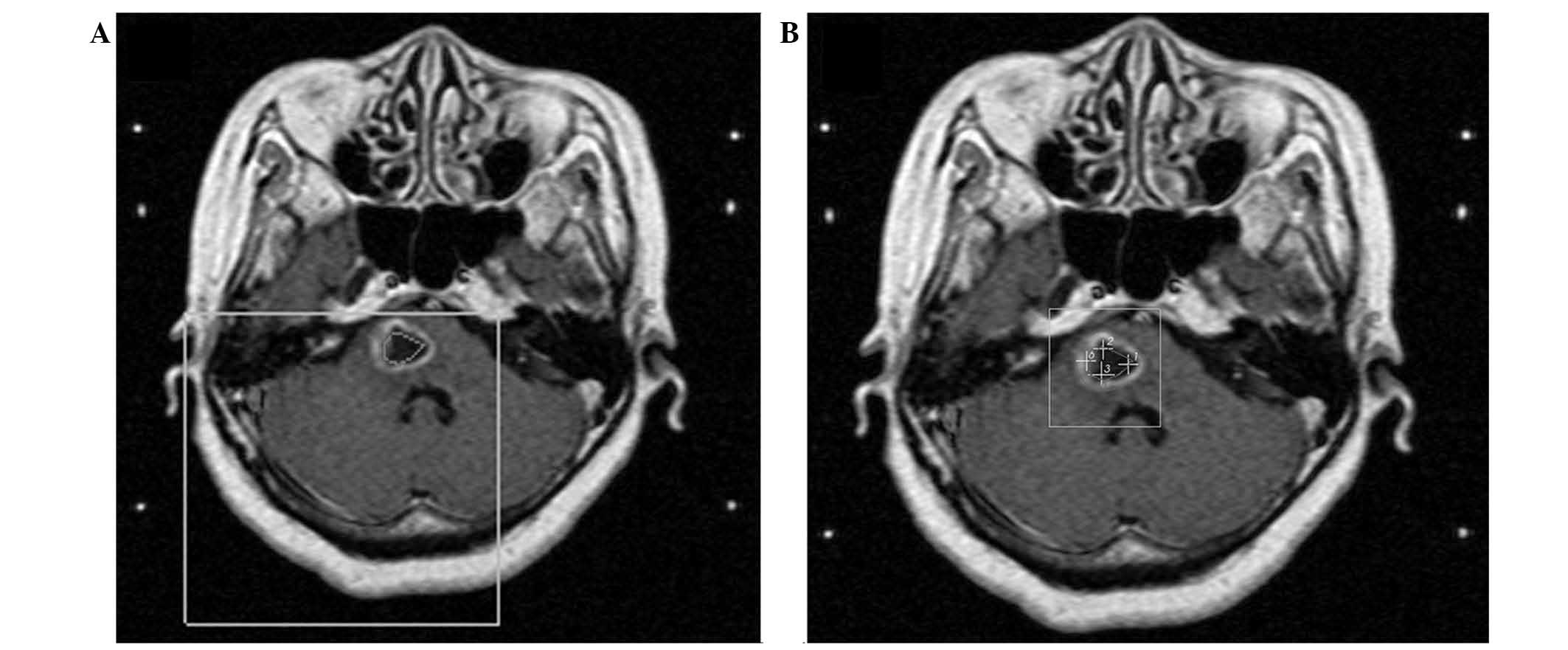|
1
|
Lamm AF, Elaimy AL, Lamoreaux WT, et al: A
review of the clinical outcomes for patients diagnosed with
brainstem metastasis and treated with stereotactic radiosurgery.
ISRN Surg. 2013:6528952013. View Article : Google Scholar : PubMed/NCBI
|
|
2
|
Huang CF, Kondziolka D, Flickinger JC and
Lunsford LD: Stereotactic radiosurgery for brain stem metastases. J
Neurosurg. 91:563–568. 1999. View Article : Google Scholar : PubMed/NCBI
|
|
3
|
Shuto T, Fujino H, Asada H, et al: Gamma
knife radiosurgery for metastatic tumours in the brain stem. Acta
Neurochir (Wien). 145:755–760. 2003. View Article : Google Scholar
|
|
4
|
Fuentes S, Delsanti C, Metellus P, et al:
Brain stem metastases: management using gamma knife radiosurgery.
Neurosurgery. 58:37–42. 2006. View Article : Google Scholar
|
|
5
|
Yen CP, Sheehan J, Patterson G and Steiner
L: Gamma knife surgery for metastatic brain stem tumors. J
Neurosurg. 105:213–219. 2006. View Article : Google Scholar
|
|
6
|
Hussain A, Brown PD, Stafford SL and
Pollock BE: Stereotactic radiosurgery for brain stem metastases:
Survival, tumor control, and patient outcomes. Int J Radiat Oncol
Bio Phys. 67:521–524. 2007. View Article : Google Scholar
|
|
7
|
Kased N, Huang K, Nakamura JL, et al:
Gamma knife radiosurgery for brainstem metastases: the UCSF
experience. J Neurooncol. 86:195–205. 2008. View Article : Google Scholar
|
|
8
|
Lorenzoni JG, Devriendt D, Massager N, et
al: Brain stem metastases treated with radiosurgery: prognostic
factors of survival and life expectancy estimation. Surg Neurol.
71:188–196. 2009. View Article : Google Scholar
|
|
9
|
Samblás JM, Sallabanda K, Bustos JC, et
al: Radiosurgery and whole brain therapy in the treatment of
brainstem metastases. Clinical Transl Oncol. 11:677–680. 2009.
View Article : Google Scholar
|
|
10
|
Koyfman SA, Tendulkar RD, Chao ST, et al:
Stereotactic radiosurgery for single brainstem metastases: the
cleveland clinic experience. Int J Radiat Oncol Bio Phys.
78:409–414. 2010. View Article : Google Scholar
|
|
11
|
Yoo TW, Park ES, Kwon do H and Kim CJ:
Gamma knife radiosurgery for brainstem metastases. J Korean
Neurosurg Soc. 50:299–303. 2011. View Article : Google Scholar : PubMed/NCBI
|
|
12
|
Hatiboglu MA, Chang EL, Suki D, et al:
Outcomes and prognostic factors for patients with brainstem
metastases undergoing stereotactic radiosurgery. Neurosurgery.
69:796–806. 2011. View Article : Google Scholar : PubMed/NCBI
|
|
13
|
Valery CA, Boskos C, Boisserie G, et al:
Minimized doses for linear accelerator radiosurgery of brainstem
metastasis. Int J Radiat Oncol Biol Phys. 80:362–368. 2011.
View Article : Google Scholar
|
|
14
|
Kelly PJ, Lin YB, Yu AY, et al: Linear
accelerator-based stereotactic radiosurgery for brainstem
metastases: the Dana-Farber/Brigham and Women’s Cancer Center
experience. J Neurooncol. 104:553–557. 2011. View Article : Google Scholar : PubMed/NCBI
|
|
15
|
Li Y, Xu D, Zhang Z, et al: Gamma knife
surgery for brainstem metastases. J Neurosurg. 117:13–16.
2012.PubMed/NCBI
|
|
16
|
Kawabe T, Yamamoto M, Sato Y, et al: Gamma
Knife surgery for patients with brainstem metastases. J Neurosurg.
117:23–30. 2012.PubMed/NCBI
|
|
17
|
Lin CS, Selch MT, Lee SP, et al:
Accelerator-based stereotactic radiosurgery for brainstem
metastases. Neurosurgery. 70:953–958. 2012. View Article : Google Scholar
|
|
18
|
Sengöz M, Kabalay IA, Tezcanlı E, Peker S
and Pamir N: Treatment of brainstem metastases with gamma-knife
radiosurgery. J Neurooncol. 113:33–38. 2013. View Article : Google Scholar : PubMed/NCBI
|
|
19
|
Jung EW, Rakowski JT, Delly F, et al:
Gamma Knife radiosurgery in the management of brainstem metastases.
Clin Neurol Neurosurg. 115:2023–2028. 2013. View Article : Google Scholar : PubMed/NCBI
|
|
20
|
Kilburn JM, Ellis TL, Lovato JF, et al:
Local control and toxicity outcomes in brainstem metastases treated
with single fraction radiosurgery: is there a volume threshold for
toxicity? J Neurooncol. 117:167–174. 2014. View Article : Google Scholar : PubMed/NCBI
|
|
21
|
Peterson HE, Larson EW, Fairbanks RK, et
al: Gamma knife treatment of brainstem metastases. Int J Mol Sci.
15:9748–9761. 2014. View Article : Google Scholar : PubMed/NCBI
|
|
22
|
Maranzano E, Trippa F, Pacchiarini D, et
al: Re-irradiation of brain metastases and metastatic spinal cord
compression: clinical practice suggestions. Tumori. 91:325–330.
2005.PubMed/NCBI
|
|
23
|
Server A, Josefsen R, Kulle B, et al:
Proton magnetic resonance spectroscopy in the distinction of
high-grade cerebral gliomas from single metastatic brain tumors.
Acta Radiol. 51:316–325. 2010. View Article : Google Scholar : PubMed/NCBI
|
|
24
|
Lü Y, Li C, Liu M, et al: MRI-guided
stereotactic aspiration of brain abscesses by use of an optical
tracking navigation system. Acta Radiol. 55:121–128. 2014.
View Article : Google Scholar
|
|
25
|
Hofmann BM, Höllig A, Strauss C, Buslei R,
Buchfelder M and Fahlbusch R: Results after treatment of
craniopharyngiomas: further experiences with 73 patients since
1997. J Neurosurg. 116:373–384. 2012. View Article : Google Scholar
|
|
26
|
Higuchi F, Kawamoto S, Abe Y, Kim P and
Ueki K: Effectiveness of a 1-day aspiration plus Gamma Knife
surgery procedure for metastatic brain tumor with a cystic
component. J Neurosurg. 117:17–22. 2012.PubMed/NCBI
|
|
27
|
Kim IY, Yun SJ, Lee JS, et al: Brain
metastasis from extramammary Paget’s disease of the scrotum. J Clin
Neurosci. 21:694–696. 2014. View Article : Google Scholar
|
|
28
|
Park WH, Jang IS, Kim CJ and Kwon do H:
Gamma knife radiosurgery after stereotactic aspiration for large
cystic brain metastases. J Korean Neurosurg Soc. 46:360–364. 2009.
View Article : Google Scholar : PubMed/NCBI
|
|
29
|
Aung TH, Kwok CK, Mark YF and Mark EG:
Computed tomography-guided stereotactic aspiration and biopsy of a
cystic metastatic adenocarcinoma of the pons. Hong Kong Med J.
3:232–235. 1997.PubMed/NCBI
|
|
30
|
Matsumoto K, Tada E, Tamesa N, Tomita S
and Ohmoto T: Stereotactic brachytherapy for a cystic metastatic
brain tumor in the midbrain. Case report. J Neurosurg. 88:141–144.
1998. View Article : Google Scholar : PubMed/NCBI
|
|
31
|
Zhao X, Du C and Tian Y: Results Of Repeat
Gamma Knife Treatment: Stereotactic Aspiration Surgery Can Improve
the Effect of Gamma Knife Treatment for Cystic Small Brainstem
Glioma: Case Report. Neurosurgery Quarterly. 22:22–25. 2012.
View Article : Google Scholar
|
|
32
|
Nakagawa K, Yasumitu T, Fukuhara K, Shiono
H and Kikui M: Poor prognosis after lung resection for patients
with adenosquamous carcinoma of the lung. Ann Thorac Surg.
75:1740–1744. 2003. View Article : Google Scholar : PubMed/NCBI
|
|
33
|
Gawrychowski J, Bruliński K, Malinowski E
and Papla B: Prognosis and survival after radical resection of
primary adenosquamous lung carcinoma. Eur J Cardiothorac Surg.
27:686–692. 2005. View Article : Google Scholar : PubMed/NCBI
|
|
34
|
Cooke DT, Nguyen DV, Yang Y, et al:
Survival comparison of adenosquamous, squamous cell and
adenocarcinoma of the lung after lobectomy. Ann Thorac Surg.
90:943–948. 2010. View Article : Google Scholar : PubMed/NCBI
|
|
35
|
Filosso PL, Ruffini E, Asioli S, et al:
Adenosquamous lung carcinomas: a histologic subtype with poor
prognosis. Lung Cancer. 74:25–29. 2011. View Article : Google Scholar : PubMed/NCBI
|
















